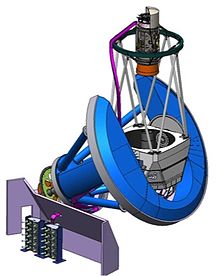Dark Energy Spectroscopic Instrument

DESI design concept in February, 2016
|
|
| Organisation | Lawrence Berkeley National Laboratory |
|---|---|
| Location(s) | KPNO, Tohono O’odham Nation, AZ, United States |
| Coordinates | 31°57′30″N 111°35′48″W / 31.9583°N 111.5967°WCoordinates: 31°57′30″N 111°35′48″W / 31.9583°N 111.5967°W |
| Altitude | 2,100 m (6,900 ft) |
| Wavelength | 360–980 nm |
| Built | Construction started 2015 |
| First light | 2019 (planned) |
| Website | Official DESI site |
|
[]
|
|
The "Mid-Scale Dark Energy Spectroscopic Instrument" (DESI) is a new instrument funded by the U.S. Department of Energy Office of Science and currently under construction. It will be located at 6880 ft. on the Mayall Telescope on top of Kitt Peak in the Sonoran Desert 55 miles distance from Tucson, Arizona. The new instrument will enable an experiment to probe the expansion history of the Universe and the mysterious physics of dark energy.
The expansion history and large-scale structure of the Universe is a key prediction of cosmological models, and DESI observations will permit scientists to probe diverse aspects of cosmology, from dark energy to alternatives to General Relativity to neutrino masses to the early Universe. The data from DESI will be used to create three-dimensional maps of the distribution of matter covering an unprecedented volume of the Universe with unparalleled detail. This will provide insight into the nature of dark energy and establish whether cosmic acceleration is due to a cosmic-scale modification of General Relativity. DESI will be transformative in the understanding of dark energy and the expansion rate of the Universe at early times, one of the greatest mysteries in the understanding of the physical laws.
DESI will measure the expansion history of the Universe using the baryon acoustic oscillations (BAO) imprinted in the clustering of galaxies, quasars, and the intergalactic medium. The BAO technique is a robust way to extract cosmological distance information from the clustering of matter and galaxies. It relies only on very large-scale structure and it does so in a manner that enables scientists to separate the acoustic peak of the BAO signature from uncertainties in most systematic errors in the data. BAO was identified in the 2006 Dark Energy Task Force report as one of the key methods for studying dark energy. In May 2014, the High-Energy Physics Advisory Panel, a federal advisory committee, commissioned by the US Department of Energy (DOE) and the National Science Foundation (NSF) endorsed DESI.
...
Wikipedia
